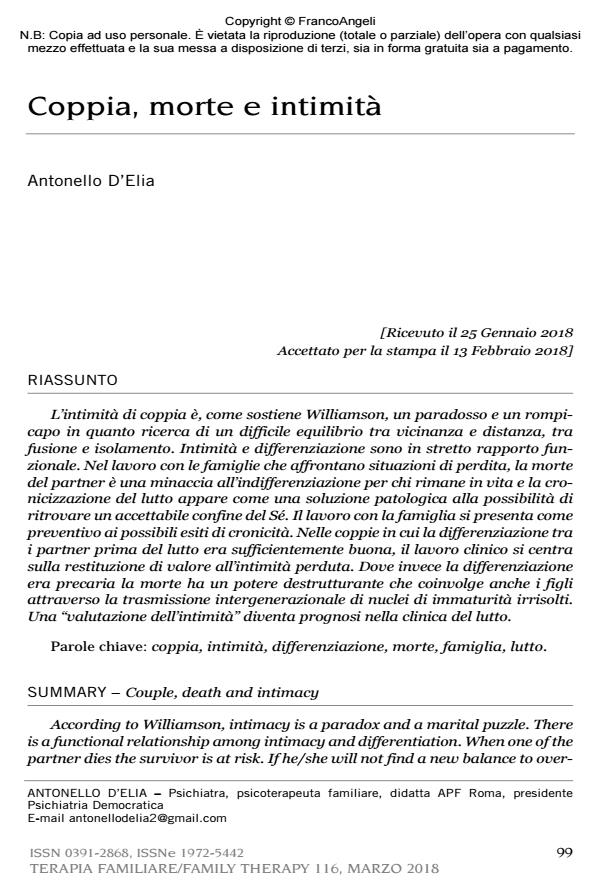Couple, death and intimacy
Journal title TERAPIA FAMILIARE
Author/s Antonello D’Elia
Publishing Year 2018 Issue 2018/116 Language Italian
Pages 16 P. 99-114 File size 96 KB
DOI 10.3280/TF2018-001006
DOI is like a bar code for intellectual property: to have more infomation
click here
Below, you can see the article first page
If you want to buy this article in PDF format, you can do it, following the instructions to buy download credits

FrancoAngeli is member of Publishers International Linking Association, Inc (PILA), a not-for-profit association which run the CrossRef service enabling links to and from online scholarly content.
According to Williamson, intimacy is a paradox and a marital puzzle. There is a functional relationship among intimacy and differentiation. When one of the partner dies the survivor is at risk. If he/she will not find a new balance to overcome the loss, cronicity seems to be a possible solution. For the couples with a previous good differentiation, clinical work aims to give new value to the lost intimacy. While partners differentiation was weak, death can lead to a distruptive outcome, even in new generations. An intimacy assessment becomes prognostic in the clinical work with families who experienced a loss.
Keywords: Couple, intimacy, differentiation, death, family, mourning
- Andolfi M. (2015). La terapia familiare multigenerazionale. Milano: Raffaello Cortina.
- Andolfi M., D’Elia A. (a cura di) (2007). Le perdite e le risorse della famiglia. Milano: Raffaello Cortina.
- Bauman Z. (1992). Mortality, Immortality and Other Life Strategies. Cambridge: Polity Press (trad. it.: Il teatro dell’immortalità, Bologna: Il Mulino, 1995).
- Boszormenyi-Nagy I., Spark G. (1973). Invisible Loyalties. New York: Harper & Row (trad. it.: Lealtà invisibili, Roma: Astrolabio, 1988).
- Bowen M. (1978). Family Therapy in Clinical Practice. New York: Jason Aronson.
- Canevaro A. (2009). Quando volano i cormorani. Roma: Borla.
- Cancrini T. (2002). Separazione, dolore e morte. In: Un tempo per il dolore. Torino: Bollati Boringhieri, 48-57.
- Chaltiel P., Romano E. (2004). L’espace fraternel dans la thérapie familiale. Cahiers Critique de thérapie familiale et de pratique de réseaux, 32: 49-65.
- Cigoli V. (2015). Spiriti e fantasmi in dialogo con i viventi, introduzione a Lai G., Spettri sul divano. Milano: FrancoAngeli.
- Cigoli V. (2016). Clinica del divorzio e della famiglia ricostruita. Bologna: Il Mulino.
- Cigoli V., Galimberti C., Mombelli M. (1988). Il legame disperante. Il divorzio come dramma di genitori e figli. Milano: Raffaello Cortina.
- D’Elia A., Del Duca D., Genovese G., Paniccia M., Thermes N., Soldateschi S. (2011). Ricostruire lo scenario vitale intorno alla morte. In: Chianura P., Chianura L., Fuxa E., Mazzoni S. (a cura di), Manuale clinico di Terapia familiare. Milano: FrancoAngeli, vol. 2, 55-62.
- D’Elia A., Del Duca D., Genovese G., Paniccia M., Thermes N. (2012). Famiglie, lutto e resilienza. In: Testoni I. (a cura di), Dopo la notizia peggiore. Padova: Piccin, 283-295.
- D’Elia A., Paniccia M. (2004). Le strade del Purgatorio. Studi Tanatologici, 5: 71-94.
- Drigo M.L. (2012). Lutti e legami. Gruppi, 2: 91-105. DOI: 10.3280/GRU2012-00200
- Framo J.L. (1992). Family of Origin Therapy, New York: Brunner Mazel (trad. it.: Terapia intergenerazionale, Milano: Raffaello Cortina, 1996).
- Furedi F. (2004). Therapeutic Culture. Cultivating Vulnerability in an Uncertain Age. London: Routledge (trad. it.: Il nuovo conformismo. Troppa psicologia nella vita quotidiana, Milano: Feltrinelli, 2008).
- Giddens A. (1992). The Transformation of Intimacy. Cambridge: Polity Press (trad. it: La trasformazione dell’intimità, Bologna: Il Mulino, 1995).
- Kübler-Ross E. (1969). On Death and Dying. New York: Scribner (trad. it.: La morte e il morire. Assisi: Cittadella, 1976).
- Minuchin S. (1974). Families and family therapy. Cambridge, MA: Harvard University Press (trad. it.: Famiglie e terapia della famiglia. Roma: Astrolabio, 1976).
- Norsa D., Zavattini G.C. (1997). Intimità e collusione. Milano: Raffaello Cortina.
- Paul N. (1967). The role of mourning and empathy in conjoint marital therapy. In: Zuk G., Boszormenyi-Nagy I. (a cura di), Family Therapy and Disturbed Families. Palo Alto, CA: Science & Behaviour Books.
- Racamier P.C. (1992). Le génie des origines. Psychoanalyse et psychoses. Paris: Payot (trad. it.: Il genio delle origini. Milano: Raffaello Cortina, 1993).
- Roustang F. (2004). Che fare delle proprie sofferenze. Terapia Familiare, 76: 5-18.
- Schnarch D. (1997). Passionate Marriage. New York: Holt (trad. it.: La passione nel matrimonio. Milano: Raffaello Cortina, 2001).
- Selvini M. (1994). Segreti familiari. Quando il paziente non sa. Terapia Familiare, 45: 5-97.
- Ternynck C. (2011). L’homme de sable. Pourquoi l’individualisme nous rende malades. Paris: Seuil (trad. it.: L’uomo di sabbia. Milano: Vita e Pensiero, 2012).
- Testoni I. (a cura di) (2012). Dopo la notizia peggiore. Padova: Piccin.
- Walsh F., McGoldrick M. (a cura di) (2004). Living Beyond Loss. New York-London: Norton & Co.
- Whitaker C., Keith D. (1982). Terapia Simbolico-Esperienziale. Terapia Familiare, 11: 95-134.
- Williamson D.S. (1982). La conquista dell’autorità personale nel superamento del confine gerarchico intergenerazionale. Terapia Familiare, 11: 77-93.
- Williamson D.S. (1991). The Intimacy Paradox. Personal Authority in the Family System. New York-London: Guilford Press.
- Wynne L.C., Ryckoff I.M., Day J., Hirsch S.L. (1958). Pseudo-mutuality in the family relations of schizophrenics. Psychiatry, 21: 205-220.
Antonello D’Elia, Coppia, morte e intimità in "TERAPIA FAMILIARE" 116/2018, pp 99-114, DOI: 10.3280/TF2018-001006